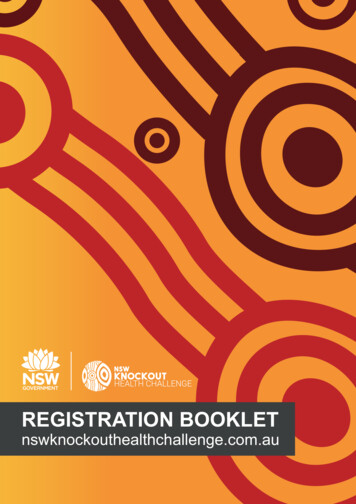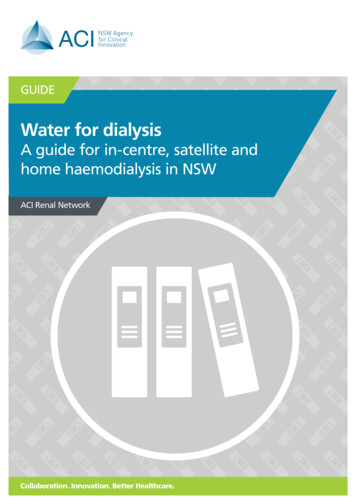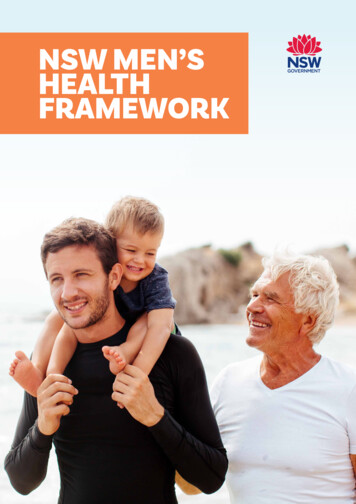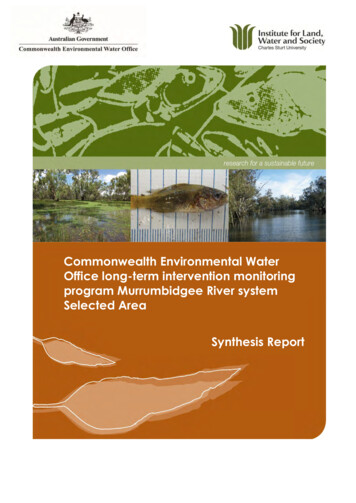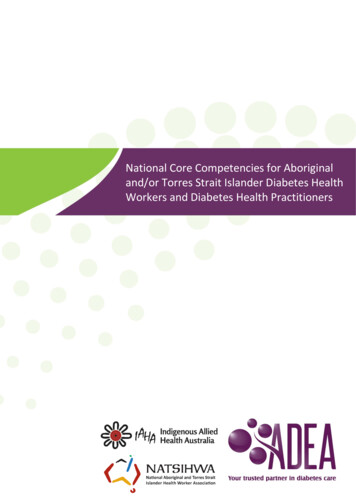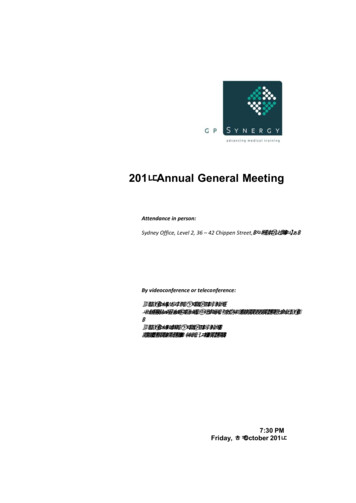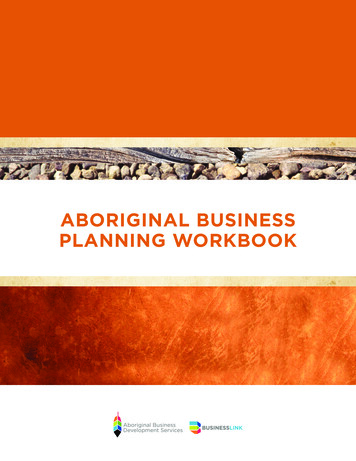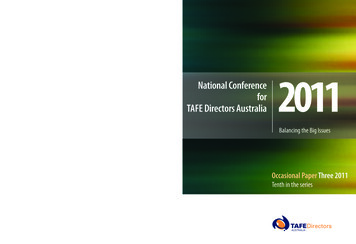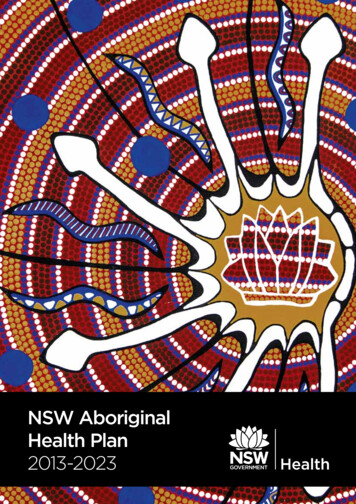
Transcription
NSW AboriginalHealth Plan2013-2023
NSW MINISTRY OF HEALTH73 Miller StreetNORTH SYDNEY NSW 2060Tel. (02) 9391 9000Fax. (02) 9391 9101TTY. (02) 9391 9900www.health.nsw.gov.auArtworkThe artwork featured on the cover of the NSWAboriginal Health Plan 2013-2023 was created byConnie Ah See, a proud descendant of the WirrumWirrum people of the Wiradjuri Nation of theWellington Valley, NSW.About the artwork:The sun has special meaning to Aboriginal people.It is the life support for mother earth. Its rays weaveacross the web of the lands bringing health andvitality to its peoples.AcknowledgementsThe NSW Ministry of Health acknowledges thevaluable support of: The Aboriginal Health Plan Working Groupcomprising representatives of the Ministry of Health,Aboriginal Health and Medical Research Councilof NSW and Local Health Districts; Participants from the consultation interviewsand workshops, and contributors who providedwritten submissions that have informed and shapedthe NSW Aboriginal Health Plan 2013-2023.CopyrightThis work is copyright. It may be reproducedin whole or in part for study or training purposessubject to the inclusion of an acknowledgement ofthe source. It may not be reproduced for commercialusage or sale. Reproduction for purposes other thanthose indicated above requires written permissionfrom the NSW Ministry of Health. NSW Ministry of Health 2012SHPN (CPH) 120410ISBN 978-1-74187-829-5Further copies of this document can bedownloaded from the NSW Health websitewww.health.nsw.gov.auDecember 2012
ContentsForeword2A Message from the Aboriginal Health and Medical Research Council of NSW3NSW Aboriginal Health Plan 2013-2023 – at a glance4Introduction5Aboriginal people in NSWDevelopment of the Plan through PartnershipPolicy ContextA Systems Perspective5779Strategic Directions10Strategic Direction 1: Building trust through partnershipsStrategic Direction 2: Implementing what works and building the evidenceStrategic Direction 3: Ensuring integrated planning and service deliveryStrategic Direction 4: Strengthening the Aboriginal workforceStrategic Direction 5: Providing culturally safe work environments and health servicesStrategic Direction 6: Strengthening performance monitoring, management and accountability101112141516Evaluation of the Plan17Abbreviations and Acronyms18Appendix19NSW Aboriginal Health Plan 2013-2023 NSW HEALTH1
ForewordImproving the health and wellbeingof Aboriginal communities acrossthe state is firmly on the NSWGovernment agenda. In partnershipwith the Aboriginal Health and MedicalResearch Council of NSW, the NSWGovernment has developed thisten-year Aboriginal Health Plan.The Plan is an acknowledgement of the significanthealth disparities between Aboriginal and nonAboriginal people in NSW and reflects the NSWGovernment’s commitment to closing this gap.To address such significant disparities it is clearthat we need to change the way we look at anddeliver Aboriginal health care. To achieve suchchange, the Plan examines the strategies thatare at the heart of the way the health systemis organised, funded and delivered and how itaffects our Aboriginal communities.HON. JILLIAN SKINNER MPMinister for HealthMinister for Medical Research2NSW HEALTH NSW Aboriginal Health Plan 2013-2023The strategic directions of this Plan considerkey issues, such as how to build respectful,trusting and effective partnerships betweenNSW Health and the Aboriginal communities itserves. Integration is key and as such addressingAboriginal health needs now and into the futurewill be more than just a priority; it will form acentral part of everything we do.Implementing this Plan and achieving its visionwill involve all parts of the health system in NSW.We all have a role to play in improving Aboriginalhealth and ensuring the well-being of generationsto come.We look forward to working with the AboriginalHealth and Medical Research Council of NSW inthe implementation of this Plan and monitoringits progress.Thank you to the many committed individualsand organisations that have contributed to thedevelopment of the ten-year Aboriginal HealthPlan. By working together we are on the rightpath to achieving a much healthier outlook forour Aboriginal communities.HON. KEVIN HUMPHRIES MPMinister for Mental HealthMinister for Healthy LifestylesMinister for Western New South Wales
A Message from theAboriginal Health and MedicalResearch Council of NSWThe Aboriginal Health and MedicalResearch Council of NSW (AH&MRC)commends the NSW Government fordeveloping the NSW Aboriginal HealthPlan 2013-2023.The Plan is the culmination of a great deal ofeffort from many stakeholders. As the peak bodyfor Aboriginal health in NSW, we believe thePlan marks a significant step in the long journeytowards achieving improvements in the healthand wellbeing of Aboriginal people in this state.The Plan is focused on changing the health systemto ensure policies and programs meet the needs ofAboriginal people. This will inevitably require abetter understanding of the context of Aboriginalpeople’s lives and the disproportionate burden ofdisadvantage within the Aboriginal population.The social determinants of health — which includeeducation, employment, housing and, importantly,the consequences of colonisation, which have hada devastating impact on the social, economic andphysical living conditions of Aboriginal people forover 200 years — directly contribute to the healthdisparities experienced by many Aboriginal people.Individuals and communities that experienceinequities in the social determinants of healthnot only carry a heavier burden of healthproblems, they often face greater barriers toaccessing services that might mitigate theseproblems. By charting a future course that aimsto remove obstacles and improve access tothese vital health services, the Plan marksan important milestone.Meaningful partnerships with AboriginalCommunity Controlled Health Services will becritical to effecting positive change. The Planrecognises the importance of strengtheningpartnerships with Aboriginal communitiesthrough the AH&MRC and, in particular, AboriginalCommunity Controlled Health Services, which arewidely acknowledged for their effectiveness indelivering comprehensive primary health care toAboriginal people. These partnerships enable theknowledge and expertise of the Aboriginalcommunity to guide the health system at everylevel, including the identification of key issues,the development of policy solutions, and thestructuring and delivery of services.The AH&MRC believes the Plan represents asignificant advance in government approaches toupholding their responsibilities to the Aboriginalpeople of NSW. We look forward to workingtogether in partnership with NSW Health toachieve this shared vision of improving the healthand wellbeing of Aboriginal people throughoutthe state.MS CHRISTINE CORBY, OAMChairperson, AH&MRCNSW Aboriginal Health Plan 2013-2023 NSW HEALTH3
NSW AboriginalHealth Plan 2013-2023– at a glanceVisionAboriginal HealthHealth equity for Aboriginal people, withstrong, respected Aboriginal communities inNSW, whose families and individuals enjoygood health and wellbeing.“Aboriginal health means not just the physicalwellbeing of an individual but refers to thesocial, emotional and cultural wellbeing of thewhole community in which each individual isable to achieve their full potential as a humanbeing, thereby bringing about the total wellbeing of their community.” 1GoalTo work in partnership with Aboriginal peopleto achieve the highest level of health possiblefor individuals, families, and communities.PartnershipThe Plan recognises the importance of theNSW Aboriginal Health Partnership betweenthe NSW Government and the AH&MRC at thestate level, and the continued need for strongpartnerships between NSW Local HealthDistricts (LHDs) and Aboriginal CommunityControlled Health Services (ACCHSs) at thelocal level.PrinciplesThe following underpinning principles areessential to achieve the Plan:1. Trust and cultural respect.2. R ecognition of the cultural valuesand t raditions of Aboriginal communities.3. W holistic approaches to the health ofAboriginal people.4. The valuable and unique role of ACCHSs.5. The participation of Aboriginal people at alllevels of health service delivery andmanagement.Strategic Directions1. Building trust through partnerships2. I mplementing what works and buildingthe evidence3. Ensuring integrated planning andservice delivery4. Strengthening the Aboriginal workforce5. Providing culturally safe work environmentsand health services6. S trengthening performance monitoring,management and accountabilityStrategic ActionsTo support achievement of these strategicdirections a range of actions have beenidentified for implementation by NSW Healthand other stakeholders.Implementation and EvaluationNSW Health is responsible for implementingthe Plan and reporting on progress. The NSWAboriginal Health Partnership will monitorprogress and oversight evaluation.6. P artnership with Aboriginal communitiesthrough ACCHSs and the AH&MRC.7. R ecognition of the contribution the healthsystem can make to the social determinantsof health.1 NationalAboriginal and Islander Health Organisations [NAIHO] definition of Aboriginal Health, restated in the National Aboriginal HealthStrategy [NAHS] 1989 ions/ accessed at 21/11/12. OATSIH (1989).4NSW HEALTH NSW Aboriginal Health Plan 2013-2023
IntroductionAboriginal people in NSWAboriginal people are the first peoples of Australia,and have strong cultures and communities. Theresilience of Aboriginal people provides thefoundation upon which to build further efforts toimprove Aboriginal health.More Aboriginal people live in NSW than in anyother Australian state or territory and improvingAboriginal health is a key focus for the NSW healthsystem. In 2011, an estimated 172,621 Aboriginalpeople were living in NSW, comprising 2.5% of thetotal population and 31.5% of the total Aboriginalpopulation in Australia. 2Relatively high numbers of Aboriginal people livein metropolitan LHDs, with over 90 per cent ofAboriginal people in NSW living in major cities orinner regional areas. While smaller numbers ofAboriginal people live in outer regional and remoteareas, they represent a higher proportion of thepopulation. For example, in Far West LHD, 9.7% ofthe population is Aboriginal, and in Western NSWit is 8.7%. 32 AustralianBureau of Statistics. 2011. 2002.0 Census of Population and Housing: Aboriginal and Torres Strait Islander Peoples(Indigenous) Profile.3 Centrefor Epidemiology and Evidence. Health Statistics NSW. Sydney: NSW Ministry of Health. Available at www.healthstats.nsw.gov.au.Accessed 19/09/2012.NSW Aboriginal Health Plan 2013-2023 NSW HEALTH5
The difference in life expectancy betweenAboriginal people in NSW and the generalpopulation is estimated to be approximately 7-9years.4 The greatest contributors to highermortality rates and excess deaths experienced byAboriginal people are chronic disease, in particularcardiovascular disease, mental health, diabetes,cancers, and injury. 5Figure 1 illustrates the population and distributionof Aboriginal people across NSW. The Aboriginalpopulation of NSW is also much younger than thenon-Aboriginal population, with more than one inthree Aboriginal people in NSW being less than 15years of age, compared with one in five for thenon-Aboriginal population.Figure 1: Aboriginal Population by Local Health DistrictPer cent Aboriginal Population by Local Health District 2011Total Aboriginal Population by Local Health District 2011NorthernNSWNorthernNSWHunterNew EnglandFar WestMidNorthCoastWestern NSWNepean BlueMountainsHunterNew EnglandFar WestWestern NSWNepean llawarraShoalhavenIllawarraShoalhavenNetworkwith VICNetworkwith VICSouthernNSWSouthernNSWGreater Sydney Metropolitan areaGreater Sydney Metropolitan area20000 to 350008 to 1012500 to 200006 to 810000 to SouthWesternSydney7500 to 100004 to 6NorthernSydneyWesternSydney3 to 45000 to 75002 to 32500 to 50001 to 2 2500Sydney ydneySource: Centre for Epidemiology and Evidence. Health Statistics NSW. Sydney: NSW Ministry of Health.Available at www.healthstats.nsw.gov.au. Accessed 19/09/2012.4 [ABS]56Australian Bureau of Statistics. 2009. Experimental Life Tables for Aboriginal and Torres Strait Islander Australians, 2005–2007. ABS.cat. no. 3302.0.55.003. Available at: 55.003 accessed on 21/11/12. Vos T, Barker B, Begg S, Stanley L, Lopez AD. 2009. Burden of disease and injury in Aboriginal and Torres Strait Islander peoples:the Indigenous health gap. Int J Epidemiol 38:47-NSW HEALTH NSW Aboriginal Health Plan 2013-2023MidNorthCoast
Multiple inter-related factors contribute to thepoorer health status of Aboriginal people. There isa clear relationship between socio-economicinequalities and the health gap. An appreciation ofthe social determinants of Aboriginal health,including the contributions of historical factors,education, employment, housing, environmentalfactors, social and cultural capital, and racism, iscritically important to closing the health gapbetween Aboriginal and non-Aboriginal people.Common behavioural risk factors, such as smoking,high body mass and alcohol misuse are bestunderstood and addressed in their social context.Policy ContextHealth policies, programs and services must bedesigned and delivered in ways that take accountof the socio-economic disadvantage experiencedby many Aboriginal people, and specificallyaddress potential barriers to access. The healthsystem can make a positive contribution to thesocial determinants of Aboriginal health, includingthrough training and employment of Aboriginalpeople, supporting ACCHSs, and building on thestrengths of Aboriginal communities in general.The commitment to close the health gap wasreaffirmed in 2010 through the NSW Parliament’sbipartisan support for the Statement of Intent toachieve health equity between Aboriginal peopleand other Australians through a comprehensivelong term plan. This commitment was made inrecognition that whilst improvements have beenmade with regard to the health of Aboriginalpeople over the past few years, there is still muchwork to do.Development of the Plan through PartnershipThe Plan has been developed through an extensiveconsultation process and in partnership with theAH&MRC. The consultation process includedstakeholder interviews, regional workshops, aforum co-hosted by Minister Humphries and theAH&MRC, and an analysis of written submissions.A discussion paper Towards an Aboriginal HealthPlan for NSW was also released on Close the GapDay in 2012, with written submissions invited.To finalise the Plan, an Aboriginal Health PlanWorking Group comprising representatives of theNSW Ministry of Health (the Ministry), AH&MRC,the LHDs and Justice Health was convened.As a high level Plan, it is recognised that the Planmay not have been able to capture all the valuablesuggestions received through the consultationprocess. It is intended, that the consultation inputwill continue to be used to inform the Plan’simplementation.There is a long standing commitment betweenthe NSW Government and the AH&MRC to worktogether to close the health gap. The NSWAboriginal Health Partnership aims to provideexpertise to enhance and support NSW Health andthe ACCHS, as represented by the AH&MRC, inhealth service provision to the Aboriginal peopleof NSW. Aboriginal self-determination, apartnership approach and the importance of intersectoral collaboration are important principlesemphasised in the Partnership.The Plan is a result of the NSW Governmentcommitment to close the health gap betweenAboriginal and non-Aboriginal people in NSW.NSW 2021: A Plan to make NSW number one,through the goal to ‘Keep people healthy and outof hospital’ specifically commits to the following: Reduce smoking rates by 4% for Aboriginalpeople by 2015. R educe the rate of smoking by 2% per yearfor pregnant Aboriginal women. H alve the gap between Aboriginal and nonAboriginal infant mortality rates by 2018. R educe the age-standardised rate ofpotentially preventable hospitalisations by2.5% for Aboriginal people by 2014–15.NSW Aboriginal Health Plan 2013-2023 NSW HEALTH7
While these priorities focus specifically onthe health gap between Aboriginal and nonAboriginal people, the NSW Government’s broadercommitments to improve the health systemwill also benefit Aboriginal people throughinitiatives to: Reduce risk drinking. Reduce overweight and obesity. Improve outcomes in mental health. Reduce hospital waiting times. I mprove transfer of patients from emergencydepartments to wards. Reduce unplanned readmissions. D ecrease healthcare-associated bloodstreaminfections. E nsure all public provided health servicesmeet national patient safety and qualitystandards. Increase patient satisfaction.For Aboriginal people in NSW to benefit equallyfrom these broad commitments, a systemsperspective is required. Hence, the Plan has adeliberate focus on what changes need to bemade to the health system to improve Aboriginalhealth, rather than a focus on specific health riskfactors or conditions.In addition to being aligned to NSW 2021, thegoals of the Plan will be supported by a number ofother strategies aimed at enhancing the health andwellbeing of Aboriginal people in NSW. The Plansupports NSW's commitments under the COAGNational Indigenous Reform Agreement includingthe National Partnership Agreements on Closingthe Gap in Indigenous Health Outcomes,Indigenous Early Child Development, andIndigenous Economic Participation. Further, thedevelopment of the National Aboriginal and TorresStrait Islander Health Plan provides an opportunityfor the NSW and Commonwealth Plans to becomplementary and mutually supportive.The Plan will need to be considered in all relevantnational and state health planning processes thatwill occur over the next ten years. In particular, thedevelopment of state health plans, rural healthplans, and strategies for primary health care, willneed to drive the strategic directions and goal ofthe Plan.The Plan will also complement the work of theNSW Ministerial Taskforce on Aboriginal Affairs,which is considering social determinants of health,particularly education and economic participation,and reforms to improve service delivery andaccountability in Aboriginal affairs across NSW.Importantly, the Plan recognises that NSW Healthhas an ongoing role in contributing to the socialdeterminants of health — through actions takenwithin NSW Health in areas such as resourcedistribution, employment policies, andmeasurement and reporting.8NSW HEALTH NSW Aboriginal Health Plan 2013-2023
A Systems PerspectiveThe health system in NSW is complex, withnumerous funders and providers of services toAboriginal people. In every part of the healthsystem in NSW, there needs to be a focus onAboriginal people, services that are delivered ina culturally competent and safe manner, and whererequired, services tailored to meet the uniqueand local needs of Aboriginal communities.To realise the vision of the Plan, the health systemin NSW as a whole needs to work in a joined upand collaborative manner – making the needs ofAboriginal people the centre of what is done.Every organisation within the system has a uniqueand important role in improving Aboriginal health.Within NSW, LHDs and Specialty Health Networks(SHNs) are responsible for promoting, protectingand maintaining the health of the community andproviding health care services. In fulfilling theirrole, LHDs in consultation with their communitieswork with the Ministry. The Ministry hasresponsibility for the planning of services thathave a statewide focus, and with other private andnon government health care organisations whichprovide care across the primary, acute and subacute settings.The planning and service delivery role of theLHDs and SHNs is supported through the specialistexpertise provided by the six pillars withinNSW Health: Clinical Excellence Commission Agency for Clinical Innovation Health Education and Training Institute Bureau of Health Information Cancer Institute NSW NSW Kids and FamiliesBeyond the organisations which make up‘NSW Health’, there are many other parts tothe health system in NSW. These include theAH&MRC, ACCHSs, Medicare Locals, theCommonwealth Department of Health and Ageing,private providers, and not-for-profit organisations.All of these entities, as well as all of NSW Health,play a critical role in delivering health services toAboriginal people. Ensuring all these organisationswork together to improve the health of Aboriginalpeople requires a systems perspective.The table in the Appendix provides a summaryof the various functions of organisations in NSWthat have a role to play in Aboriginal health.NSW Aboriginal Health Plan 2013-2023 NSW HEALTH9
Strategic DirectionsStrategic Direction 1: Building trust throughpartnerships by building relationships with andbetween service providers, particularly theAH&MRC and ACCHSs to foster participation inservice planning, design and implementation.During the consultation for the Plan, manyrespondents strongly endorsed the need forgenuine participation of Aboriginal communities instrategy and action planning at all levels of thesystem. To support Aboriginal communityparticipation, partnerships with ACCHSs need tobe formally supported.At a state level, the NSW Aboriginal HealthPartnership, between the NSW Government andthe AH&MRC, facilitates the expertise andexperience of Aboriginal communities beingbrought to a broad range of health care processes.This expertise comprises knowledge of Aboriginalculture and health care, as well as clinical serviceprovision of the AH&MRC's member services.Similar partnerships are required at the local level.Local partnerships need to create trusting and10collaborative working relationships, facilitating acoordinated approach to local action so as to meetlocal needs of Aboriginal communities, as well asbuilding community capacity. There is a need forcoordination across all health services at the locallevel, including through ACCHSs, LHDs, MedicareLocals, other non government organisations andprivate service providers.LHDs will take steps to strengthen theestablishment and operations of Aboriginal healthpartnerships and build these partnershiparrangements into their governance andaccountability structures. Specifically, they will:respect and support the roles of ACCHSs, supportlocal services to plan, collaborate, take action andrespond to the strategies advocated for in thePlan, define new roles and responsibilities toreduce duplication of effort, build trust andcultural safety, and work to clarify and integratepathways of care across prevention, primary,secondary and tertiary services. Integration ofplanning and service delivery is covered inStrategic Direction 3.Strategic ActionsResponsibleWork in partnership with the AH&MRC to strengthen and continue to developthe operation of the state-level NSW Aboriginal Health Partnership.MoH, PillarsReplicate the state-level partnership locally between ACCHSs and LHDs,so that at each level of NSW Health there is strong engagement.MoH, LHDsSupport the AH&MRC to develop partnership arrangements with the Pillars andother state health organisations.MoH, Pillars, SHNsWork in partnership with the AH&MRC to identify and disseminate models ofbest-practice partnerships, and strategies to build capacity to participatemeaningfully in partnerships, at all levels of the system.MoH, PillarsWork in partnership with the AH&MRC to develop performance indicators andtrial methodologies to evaluate the functioning and effectiveness of partnershipsat all levels.MoH, LHDs, PillarsEmbed Aboriginal health partnerships within performance managementand accountability mechanisms at all levels in NSW Health.MoH, LHDsNSW HEALTH NSW Aboriginal Health Plan 2013-2023
Strategic Direction 2: Implementing whatworks and building the evidence by supportingquality research and evaluation, disseminatingevidence of effective programs and services, andsupporting the translation of evidence into policyand practice.A key theme during the consultation was that thePlan must support a strategic approach to thedevelopment, dissemination and activeimplementation of evidence. All programs andservices, whether mainstream or specific toAboriginal people, need to be informed byevidence of what works for Aboriginal people.There is considerable activity underway withregard to building the evidence base in Aboriginalhealth. To answer the question, “How are wedoing?”, approaches characterised as research orprogram evaluation can be used. These processesare related, and it is important that the insightsgained from them are integrated.6 All theseapproaches are important to improvingAboriginal health.Ethical and culturally relevant research andevaluation in the field of Aboriginal health needsto be supported. Further, the importance ofunderstanding Aboriginal communities’perceptions and understandings of what worksbest for their communities needs greaterappreciation. Actively translating evidence intopractice will be key to ensuring the implementationof what works.As part of improved information about what worksin Aboriginal health, improving data quality is alsoessential. There are numerous data collectionsacross the health system that include informationabout Aboriginal people’s health: working toimprove the quality and accuracy of these datasets with regard to Aboriginal people will be anongoing requirement.Strategic ActionsResponsibleReview research programs supported by NSW Health and identify opportunitiesto strengthen their focus on Aboriginal health.MoH, PillarsWork in partnership with the AH&MRC to support quality evaluations ofAboriginal programs to ensure they measure meaningful outcomes.MoH, LHDs, PillarsSupport quality evaluations of mainstream programs to ensure their effect onAboriginal people is measured.MoH, LHDs, PillarsImplement quality improvement strategies in data collection (particularlyidentification of Aboriginal clients) and reporting related to Aboriginal people inall health system settings.MoH, LHDs, PillarsWork in partnership with the AH&MRC to disseminate and apply the findingsof research and evaluation through strategies to help translate evidence intopractice.MoH, LHDs, PillarsWork in partnership with the AH&MRC to review the needs of the healthworkforce across NSW with regard to research and evaluation skills, andimplement strategies to build the capacity of the workforce to undertakeresearch and evaluation in Aboriginal health.MoH, LHDs, Pillars6 Introductionto Program Evaluation for Public Health Programs: A Self-Study Guide, Centers for Disease Control and Prevention, ex.htm accessed on 21/11/2012.NSW Aboriginal Health Plan 2013-2023 NSW HEALTH11
Strategic Direction 3: Ensuring integratedplanning and service delivery by working withCommonwealth agencies, other NSW Governmentagencies and relevant local and state partners toachieve shared planning and service delivery thatreduces duplication, is efficient, and improvesaccess and utilisation.The health system in NSW is complex, withnumerous funders and providers of services toAboriginal people. It was evident from theconsultation that there can sometimes be aninconsistent and uncoordinated approach toAboriginal health service planning across NSW.This is compounded by different fundingarrangements, which can lead to duplication andfragmented service provision. In turn, thisperpetuates barriers to access and serviceutilisation, and can lead to reduced effectivenessand efficiency.To achieve an integrated planning and servicedelivery approach in NSW, NSW Health needs towork with the Commonwealth, the AH&MRC,ACCHSs, Medicare Locals and Aboriginalcommunities. Coordinated approaches to reduceadministrative burden and streamline reporting arerequired. Figure 2 illustrates the settings in whichhealth care is provided, and the need forintegration between levels of care, and acrossservice providers.This Strategic Direction is closely linked withStrategic Direction 1, in that without strongpartnerships, integrated planning and servicedelivery cannot be achieved.Figure 2: Health service settings in NSWHospital Base CarePublicHospitalsPrivateHospitalsPrimary Care ServicesMedicareLocalsGPsLHDsACCHSsNon GovtProvidersPrivateProvidersPrimary PreventionLHDsPrimary ntNon GovtProvidersIntegration across service providers12NSW HEALTH NSW Aboriginal Health Plan 2013-2023LocalACCHSsGovernmentIntegration between the levels of careHighlySpecialisedTertiary Services
Strategic ActionsResponsibleWork with the Commonwealth Government and the AH&MRC to identifyopportunities to coordinate service planning, integration of programs acrossproviders, funding, and reporting.MoHWork with the AH&MRC to ensure that the needs of Aboriginal communitiesare addressed within the strategic plans of all Pillars and other state healthorganisations, and that there is regular reporting to the NSW Aboriginal HealthPartnership on progress.MoH, Pillars, SHNsCollaborate with local ACCHSs in the development of LHD health care plans toachieve a shared, coordinated, and joined up approach to service delivery.LHDsWork with the AH&MRC to address the needs of Aboriginal communities throughspecific planning processes for priority health issues, for example in the areas oftobacco control, chronic disease, and child and maternal health.MoHEnsure that all relevant NSW Health policies, programs and services considerAboriginal people as a priority population and reflect th
Plan 2013-2023. The Plan is the culmination of a great deal of effort from many stakeholders. As the peak body for Aboriginal health in NSW, we believe the Plan marks a significant step in the long journey towards achieving improvements in the health and wellbeing of Aboriginal people in this state. The Plan is focused on changing the health system

